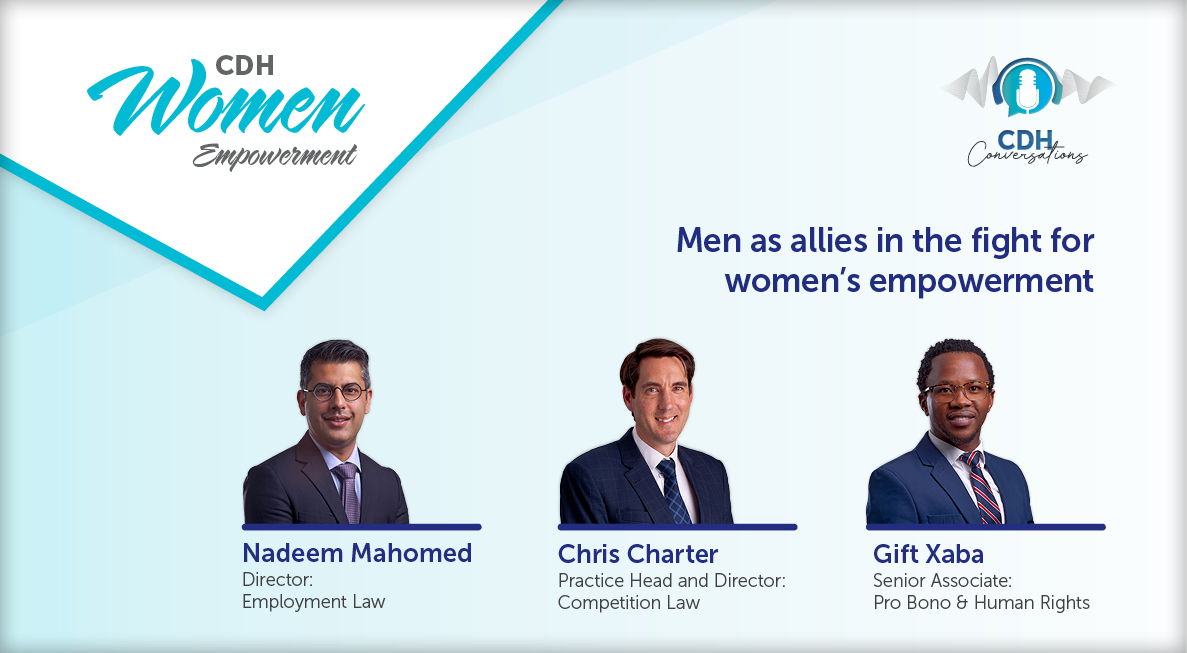Preparing for the Department
At a glance
Prof Hugo Pienaar and Leila Moosa discuss employment policy and procedure requirements that employers should have front of mind when considering how the employment equity amendments may impact their business and its implementation of the Employment Equity Act, 1998.

Preparing for the Department
Podcast
Preparing for the Department
Podcast
Transcript
Nadeem Mahomed: Welcome to CDH conversations. My name is Nadeem Mahomed. I'm the professional support lawyer in the employment law department at CDH. This is the 4th instalment in our podcast series on the Employment Equity Act Amendments. The effective date of the amendments is yet to be proclaimed by the President and the sectoral numerical targets were published by the Minister of employment and labour on the 12th of May 2023. Interested parties have 30 days to comment on the sectoral numerical targets. Today, to further discuss the Employment Equity Act Amendments, we have Professor Hugo Pienaar, a director in our employment law department, as well as Leila Moosa, who is a Senior Associate in our employment department. Welcome and please continue.
Prof Hugo Pienaar: Thank you, Nadeem. So the topic is preparing for the department. And what we do know, it means preparing for the department. It's potentially meaning preparing for court. And that would mean that you'd already put your annexes for your court papers in place, and all your records. And those records that I'm referring to are all the records that should be in place, by the time that you have your visit from the department in whatever format that'd be by the inspector, or otherwise. But just maybe before we get into this topic in more detail, we all have these fears of these huge penalties to be imposed by the courts, when we don't get this right, whether it's in terms of preparation, documents, compliance, or whatever. And then we see penalties of 2 - 10% of turnover or 2.7 million rand. And my sense is that if Leila can just give us some sort of assurance as to whether the court has a punitive approach, or a different sort of approach when they're going to assess our compliance after we've done this preparation, and had the meeting with the department.
Leila Moosa: Thanks very much Prof. So I think this is really important for designated employers to understand about how potential penalties are implemented by our courts, if any. And the approach that we've seen in the case law is that the courts do not have a punitive approach. But rather they attempt to use the potential of imposing fines as a means to encourage regulatory action in terms of what is required in terms of the act. So we have seen in the past, that where penalties have been considered by our courts, they've actually required the consideration of a number of factors where they've used the substance over form approach to check whether in fact, the labour inspectors or the director general, whomever would have brought that toward the court, actually considered those factors and made a proper value judgement based on the factors that are in terms of the act. And there we've seen that it's not on each occasion that a fine is imposed. And even when it is imposed, we're not seeing that it's the maximum penalty, but rather that the situation of the employer, including the size of the environment within which they operate in, amongst other factors are being considered to assess what that fine, if any, may look like.
Prof Hugo Pienaar: Thank you, Leila, for that assurance. So let's start with our preparation. And we're going to end with the analysis in particular, given the new targets. But the starting point my sense is really, they're going to look at all our policies and procedures, whether there are possible barriers that you need to determine in terms of section 15 of the Act. So just give us a sense of these policies and procedures. And then we can touch on one or two of those.
Leila Moosa: Of course, thanks, Prof. So there are a number of these that are set out in the Act. And to a large degree, they haven't changed in terms of the the broader categories that are required, so designated employers would be familiar with what these requirements are. As a starting point, one of those would be the preparation of the Employment Equity Plan, which employers would be familiar with. And with the new employment equity amendments, which as Nadeem has said, the effective date is yet to be proclaimed.
The potential numerical goals that may be set from a numerical sectoral perspective, in terms of the new section 15 A of the Act would also be included in terms of that Employment Equity Plan. And then another example are the Employment Equity Reports which a designated employer must submit to the Director General once a year. And there are also additional requirements; that there's publication of that report or a summary of that report in terms of the employer's Annual Financial Report. There is also an administrative requirement internally, that a designated employer assigns a manager, that is a person who has a particular level of seniority and understanding of the requirements in terms of the Act. And then there are also some requirements around duties to keep records, as well as the duty to actually ensure that persons within the workplace are properly informed. And this may include displaying in the workplace, in the prescribed form the actual provisions of the Act, which is summary form, as well as ensuring that a copy of the plan, for example, is available to employees for consultation if necessary.
Prof Hugo Pienaar: Thank you. So we know that there's this duty to do an analysis and to collect information with regards to policies and procedures, but also about the profile. And now it goes beyond what we've done historically, because we will now do an analysis of our profile. And that would be on a national basis and on a regional basis. And on top of that, look at our employment equity reports in the past, compare that with the targets we've set in the past. And then is it correct later that we will then look at the new target set to determine what challenges we may or may not face?
Leila Moosa: That's correct, Prof. That's an important assessment for designated employers to actually make at this stage because these may change as we may see applicable sectoral numerical targets that may be required to be considered.
Prof Hugo Pienaar: Correct. Now, the difficulty is that many employers struggle to reach those current targets they've set in particular where there was pressure on them to set higher targets from the department or otherwise. And this will be a further challenge now to reach those targets within the relevant timeframes. Now, the reason why I mentioned that, and why I want to focus on that for the moment is that we will then go back to Section 42 and see; what are the factors to be considered for why we've not reached our targets. And that brings us back almost to where we started, Leila. And that is, we will have to revisit our policies and procedures. Are there perhaps barriers and the barrier that I just want to mention for the purpose of this discussion is often employers have a Recruitment Policy, and it says:
We will give preference to internal candidates if there is any vacancy.
Now, when you talk at a higher level of employment and categories of employment, you often find that because of historical and other reasons, those mostly consist of white males. So if you have that rule and there's a vacancy, you will give preference to your existing employees, which will just ensure another white male, by way of example, to take up that position. And we would encourage people to revisit that as a potential barrier. So that, especially at the higher level where there's underrepresentation, that you revisit the Recruitment Policy and get rid of that requirement before you and when you recruit. Any sense from our clients in terms of that or your view of that, Leila?
Leila Moosa: Thanks, Prof. So I think that that's extremely valuable. And we have seen in industry that designated employers and other clients that we've been dealing with, have actually been engaging these internal due diligence, where they're requiring their human resources and their people teams to actually sit, perhaps with their legal teams if they've got them, and to actually think about how what they have in place resonates now with the potential employment equity requirements as they would exist in the amendment form. And this is really a dynamic exercise that requires some revisiting and some reconsideration of what this may mean, when we have all of these amendments in place and employers are actually required to adjust how they operate to ensure compliance.
Prof Hugo Pienaar: Great. What we're going to do for the preparation, of course, is record keeping and how long, and I'm now talking about all records that are required; from your minutes of your employment equity meetings, your minutes how you said, did you do your analysis, the moment that you've set up your section 21 report, all of those we need to keep minutes of and of course records where it's about how we did our recruitment. How long must we keep those records, Leila?
Leila Moosa: Thanks Prof. So in terms of the Act, it speaks of a prescribed period for which those records must be kept. And that prescribed period is from time to time set out in the regulations and at the moment that sits in terms of the country regulations at a period of five years. So employers are required to keep those records for a period of five years and should also note that with accurate record keeping requirements in terms of section 26 is one of the potential sections that could, after obviously the provisions in the Act are followed, result in the imposition of certain penalties in terms of the schedules. So that is definitely one for employers to watch and to ensure that they are complying with.
Prof Hugo Pienaar: So my sense is, Leila and helped me, that employers have these new targets that they must consider. They must revisit it and compare it with the unemployment equity target set. Go back to the drawing board where they were short on numbers, or otherwise reestablish with the relevant employment equity committee, or the other role plays as determined in terms of the Act, keep proper record and determine why or why not we have reached certain targets. Would that be correct? And then of course, again, keep proper record of that.
Leila Moosa: Of course Prof, I think that that's exactly it, taking a step by step approach, and actually just breaking it down into what they are required in the way that you've described would be the recommended approach for employees at this stage. Because looking at it at big picture might seem as though there's a lot to do, but in actual effect, you know, it really just takes simply looking at what those requirements are, and piece by piece unpacking them and requiring and actually assessing whether there is something more that needs to be done. And then once that's figured out, taking the steps to ensure compliance.
Prof Hugo Pienaar: And just on a practical basis, we've seen these visits by the departments, and often it's a small employer or owner business. And there's one person at the top with two family members below that person, and the difficulties of course, you then have employment of people of let's say, closer or not close to retirement. And it's very difficult for you to take one of those people out and simply replace that person with somebody else, because that may itself create a problem. But the important point is that you have proper record of when those people were appointed, have the context of employment ready, show there's a retirement age. So you go back almost to Section 42 to determine; why do I not reach those targets? What are the assessment factors to be complied with and consider in terms of section 42? And remember, in terms of 42, the last clause that deals with assessment of compliance as any other prescribed factors? And then it's worthwhile to always go back into this previous amendments to Section 42 and say:
What other factors did they historically look at i.e. labour turnover? What was the progress made by similar organisations in the same industry? What's the financial position of the company?
Because historically, those were listed in terms of 42, but it's not there anymore. But again, it brings us back to the point Leila has raised. And that is the record keeping because if you have that visit from the department, ideally have all those records in place. They often give you notice in advance of their visit, or they give you notice in advance of documents that they want, please comply with that, so that when you have that visit, that you start off on a good footing. But of course, the whole question is now and target is a different one. And that will of course always be subject to what extent there will be litigation on this topic, similar as we've seen with the BBBEE legislation where there are targets set targets quote, unquote, and we expect certainly, some litigation before this piece of legislation, heats to each enforcement stage.
Nadeem Mahomed: Thank you for Pienaar and Leila for that very informative discussion. Before we bring this to a close I would like to remind our listeners that they should look out for our thought leadership guideline which will be published sometime next week. Thank you for tuning in. Bye.
The information and material published on this website is provided for general purposes only and does not constitute legal advice. We make every effort to ensure that the content is updated regularly and to offer the most current and accurate information. Please consult one of our lawyers on any specific legal problem or matter. We accept no responsibility for any loss or damage, whether direct or consequential, which may arise from reliance on the information contained in these pages. Please refer to our full terms and conditions. Copyright © 2025 Cliffe Dekker Hofmeyr. All rights reserved. For permission to reproduce an article or publication, please contact us cliffedekkerhofmeyr@cdhlegal.com.
Subscribe
We support our clients’ strategic and operational needs by offering innovative, integrated and high quality thought leadership. To stay up to date on the latest legal developments that may potentially impact your business, subscribe to our alerts, seminar and webinar invitations.
Subscribe



